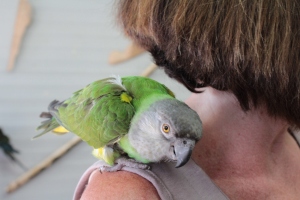I like when current events in the media combine to illustrate animal welfare in our society. This week’s blog post was impossible to resist.
Recently there was a bit of hubbub over a group of scientists discovering what they described as … a freaking puppy sized spider (emphasis mine, extra Raid cans also mine).
The scientists released a blog and the media picked it up and ran with it (because it was a freaking puppy sized spider. It wasn’t even chihuahua sized, this is a decent sized puppy we’re talking about. No I’m not linking to a picture. Google that yourself. Go on. Type ‘puppy sized spider’ in there. I dare you).
But here comes the twist in the tale (the puppy sized spider tail . . . wait, that doesn’t really work, does it?). Our intrepid scientist started to receive death threats and abused because he collected a specimen. And ‘collected’ in this sense means in the more Victorian sense. There is one less puppy sized spider in the world.
Piotr, for that is our scientist’s name, has written an excellent blog post describing the necessity of biological sampling, and the danger of assuming that any of us lead a guilt free life. I strongly encourage you to read it, but I’ll include this quote:
We kill thousands of organisms without realizing that we do it. Look into the light fixtures of your house or the grill of your car, they are full of dead insects and spiders.
It is all but impossible to live a life that does not harm animals in some description, and for the most part (legally, and culturally) we often excuse ourselves by protect vertebrates. I’m really fascinated by the outrage that has come up around a spider.
This week, TV presenter Chris Packham penned an open letter to the presenters Ant and Dec asking them to put a stop to the ‘animal abuse’ in their show ‘I’m a Celebrity Get Me Out of Here’. The show typically features ‘celebrities’ eating live bugs on screen as a challenge, or in one memorable case, a contestant caught, killed and ate a rat. Packham says:
“I can guarantee that some animals are harmed during production, because they are fragile or easily stressed. Or simply killed, as they are in your bushtucker trials.”
Are we heading toward a new age of invertebrate animal protection?
I have a visceral reaction to that spider. It makes me feel unwell. Yes, I am an arachnophobe (I’m not fond of any insect really), even the cute ones like the Peacock Spider are only tolerable when they are an image on a screen. When I see a spider the space between my shoulderblades begins to twitch and my heart begins to pump. Fear this, my body tells me, and even when I’m trying to be cool in front of other scientists, I cannot bring myself to approach. I have never held a tarantula, even though I’ve had copious opportunities to do so, because I simply would not be able to control my muscles long enough to do so.
It’s Okay To Be Smart did an interesting vid on this recently, but that’s not the point of this post. The point of this post is to discuss whether we, as a society, think it’s acceptable to harm invertebrates.
I have beliefs about the way you should treat animals. This set of beliefs arises from my experiences, my knowledge, my culture and my society. This is my ethical viewpoint. You can explore the most common ethical viewpoints and how you stack up on the excellent Animal Ethics Dilemma website.
My ethical viewpoint has changed over the years, as has yours no doubt. Our ethics can even be formed by different thought processes. Some people will describe their ethics based on how things make them feel. As a utilitarian, I try to remove my feelings from the process of making an ethical judgement (interestingly, a small study of 38 students showed that the way they reacted to images of humans experiencing injustice and unfairness influenced the way their higher-order ‘computational nodes’ of the brain – in essence it was the logical parts of the brain that react in cases of injustice, Yoder & Decety (2014). It would be fascinating to repeat this with other age groups, and with animal scenarios too. The point being that your desire for social justice does not necessarily have to be based on the emotional centres of your brain). Regardless of how your ethical viewpoint was formed, you believe it to be right. When people act against their ethical values, they can be deeply distressed.
Now some people believe you should harm no animal at all. They believe that animals have an absolute value and that we have no right to use them. To live in such a way that upholds the absolute value of all animals is very difficult. The kingdom ‘Animalia’ (the simplest way to define animals, really) encompasses a huge range of beasts: do the sponge and the jellyfish have the same absolute value as the elephant and the tiger? Every time you swat a fly, uproot a worm, or even tell a dog not to eat the cat’s food you could be violating that absolute value.
This is a difficult (though not impossible, see Jainism) way to live. But most people begin to take a more centrist position by believing that animals have an intrinsic value. We must justify their use in some way. Some justifications are easier than others. I always find the fish eating vegetarian to be a fascinating example of this. Many species of fish (which is an arbitrary group of animals anyway) have very sophisticated nervous systems and are capable of pain and suffering. Killing them humanely is difficult and catching them humanely even more so. But for many people, their ethical viewpoint can accept the death of a fish, but abhors the death of a chicken. This often comes from a relational viewpoint, where animals are prized for the way we interact with them. Most people have fewer interactions with a fish than they do a chicken or a cow, and the life of a fish is more unimaginable.
And then on the other side, some people believe that animals have an extrinsic value, that we may use them as we wish.This is more common than you might think. The cat owner who takes his cat to the vets to be euthanased because he no longer wants it is assigning its life extrinsic value. When the owner no longer takes value from the animal, the life becomes disposable.
This scale of values exists in conjunction with the various ethical viewpoints we have. I myself am a utilitarian who believes animals have an intrinsic vale. I use animals. I am also rather broad in my description of animals. For example, I’ll eat any animal so long as I can be satisfied of two questions: “Did the animal have a good quality of life/human death?” and “Will eating this animal negatively impact my health or welfare?” Now that doesn’t mean I question every animal product that passes my lips, I am more than sure I have eaten poor welfare meat (as we discussed in our kosher post), but this ethical standpoint and my view of animals’ values guides my actions.
However there is an element of the ‘relational’ ethical viewpoint for me. I don’t have good relationships with invertebrates, and I don’t have the same emotional reaction to their injury that I do to a vertebrate’s injury. With that being said, we describe invertebrate harm as ‘cruel’ and ‘worrying’ in several cultural contexts. Imagine the cat playing with the spider, batting it from paw to paw, tearing it limb from limb. We frequently stop our cats from doing this, in part because we are disgusted, but in part because we recognise that must be an unpleasant experience for the spider. Cats are cruel and toy with their prey (probably because they don’t recognise their prey as sentient, but with cats you never know . . .)
And then there is the case of the little boy burning ants. It’s a short hand we use for unthinking cruelty in our media, or to indicate that a character will go on to become cruel. And yet invertebrate experimentation like this is a common experience for many of growing up.
What is the difference, ethically speaking, in killing a spider for entertainment (I’m a Celebrity) and killing a spider for science (the puppy sized specimen). In both cases, a spider dies, surely the ethical line is one drawn in the sand?
Well, no, I don’t think so. It’s often tempting to write off ethics as nebulous and personal, but there are many, many reasons to support both the collection of the puppy sized spider and the banning of invertebrate eating on I’m a Celebrity…
- The ‘greater good’ of media vs science. How much does the entertainment of seeing people eat spiders benefit society? Not a huge amount, the trials could be replaced by something equally disgusting and memorable (smelly tofu springs to mind, indeed what one of the previous winners of I’m a Celebrity ate as a vegetarian). Indeed you could argue that the destruction of animals for entertainment is an overall negative for our society, as Packham outlines.
- By contrast, the ‘greater good’ we get from understanding the physiology of the Goliath spider is a scientific contribution to our understanding of the world. I prize knowledge over entertainment.
- Which brings me on to volume – the number of spiders which die for this scientific need is less than the number which die or are fatally injured for this case of entertainment.
- And this brings me to the method – the method of killing on I’m a Celebrity is one which we might reasonably consider to be a high-stress environment, even for what we know of spider perception. Whereas we might expect the passionate scientist to have a calmer, more human approach.
At the end of the day, if you feel animals have an extrinsic value, neither of these spider deaths will upset you. If you feel they have absolute value, both these deaths will upset you.
But most of us lie in the middle zone, where intrinsic value must meet the benefit our society gets from either entertainment or knowledge. And it is here that the great ethical debates come in.
Regardless, threatening the scientist is not going to help anyone.


